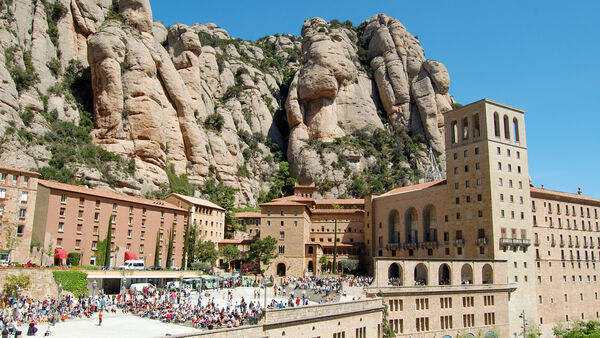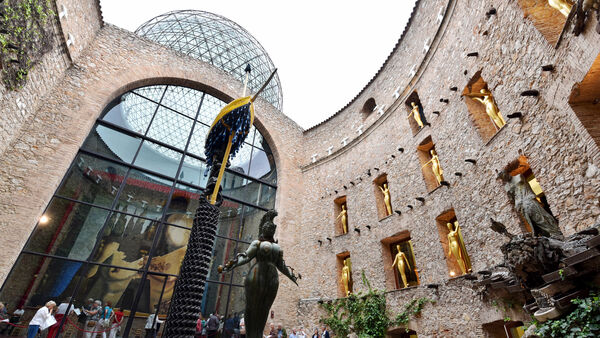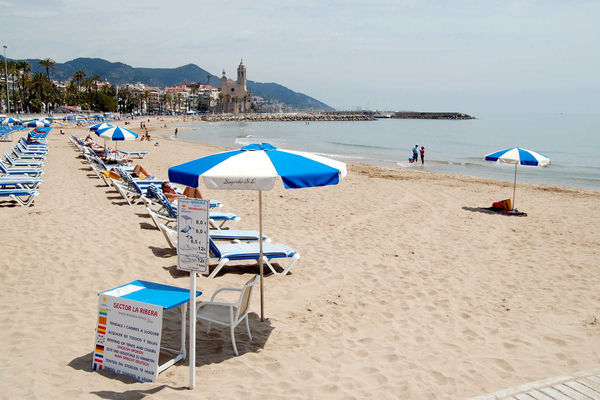Beyond Barcelona: Montserrat, Figueres, Cadaqués, and Sitges
By Rick Steves


It's hard to top Barcelona, Spain's most cosmopolitan and fun city. But it's still worth considering at least one of several temping, scene-changer day trips from Barcelona: the mountaintop monastery of Montserrat, the Salvador Dalí museum at Figueres, and the seaside towns of Cadaqués (with Dalí's home) and Sitges (great beaches).
For almost a thousand years, Benedictine monks have lived atop Montserrat — the "serrated mountain" — which dramatically rockets up from the valley floor northwest of Barcelona. With its unique rock formations and dramatic cliff-clinging monastery, Montserrat is an inviting excursion for pilgrims with (or without) hiking boots. A one-hour train ride from Barcelona links up with a rack railway or a cable car to get you to the lofty site. Serious pilgrims walk up.
Legend has it that in medieval times, shepherd children saw lights and heard songs coming from the mountain. They traced the activity to a cave, where they found a statue dubbed "La Moreneta" — the Black Virgin. The monastery quickly became a pilgrim magnet. The small wooden Mary is now behind protective glass in the Montserrat basilica, but the royal orb she cradles in her hand is exposed, ready to receive the venerating touch of the faithful. Newlyweds in particular seek this Mary's blessing.
For hikers and nature lovers, a funicular climbs nearly a thousand feet above the monastery. Up top, the air is fresh and the views are spectacular, sweeping — on the clearest days — from the Mediterranean to the Pyrenees. From the trailhead here, well-signposted hikes radiate out.
If you're a Dalí devotee, head to Figueres (two hours north of Barcelona) and the strange, fanciful Dalí Theater-Museum. From the Figueres train station, it's an easy 15-minute walk to the museum. You can't miss it: It's painted pink, studded with golden loaves of bread, and topped with monumental eggs and a geodesic dome. For fans of Surrealism and Dalí, it's one of Europe's most enjoyable museums.
Wandering around the building (a former theater), I can't help but wonder: Am I crazy, or is it Dalí? Pop a coin into Dalí's personal 1941 Cadillac, and it rains inside the car; peek into the Mae West room to see that the sofa lips, fireplace nostrils, painting eyes, and drapery hair come together to make the face of the sultry actress. And Dalí himself is entombed in a crypt below center stage.
Nearby Cadaqués is a seaside gem at the easternmost tip of Spain. With whitewashed buildings and dreamy bay views, Cadaqués is idyllic and remote-feeling. (It has no train service; buses and taxis connect it to Figueres along a tiny access road.)
Most travelers in Cadaqués are here to see the home that Dalí shared with his wife (and muse) Gala. Together they converted a fisherman's home — about a 20-minute walk from the city center — into their semipermanent residence. It was here that Dalí did his best work, and I consider it the most interesting home of a deceased personality in all of Europe. Though Dalí was raised in Figueres, he spent childhood summers in a family cabin here in Cadaqués, where he was fascinated by the rocky landscape that would later be the backdrop for many Surrealist canvases.
Though Cadaqués otherwise offers little in the way of sights, the old town is remarkably characteristic. I love to stroll along the waterfront or climb to the Church of Santa Maria for commanding views from the top of town. Uphill, Cadaqués' Jewish Quarter is still rich with vestiges of the strong Sephardic community that thrived in Spain until 1492.
If you simply want to kick back without an agenda, take the frequent 30-minute train service from Barcelona to welcoming Sitges. With a much slower pulse than Barcelona, this resort town southwest of the city is a perfect break from sightseeing. Sitges has jet-set status, but it's hung on to its Old World charm while managing to be both family- and gay-friendly.
There are Modernista-style mansions here and a few worthy little museums, but I recommend just poking around the old town's whitewashed streets, crammed with cafés and boutiques. Then head for the water to soak up the sun, sea, and sand on one of nine beaches that extend southward. Along the seaside promenade, you have your choice of restaurants and chiringuitos (beachfront bars) for tapas, paella, and drinks.
If you happen to visit during one of Sitges' two big festivals (St. Bartholomew in late August and St. Tecla in late September), you may see teams of castellers competing to build human pyramids up to 60 feet high. Balancing on the shoulders of the people below, the castellers are judged by how quickly they can assemble and take down their people towers. No one is really sure how this quirky tradition got its start, but it's a perfect reflection of the region's team-building bent.
Skipping out of Barcelona for the day is easy. Whether you experience the sacred, the surreal, or the seaside, you'll return to the city recharged and ready for all it has in store.

